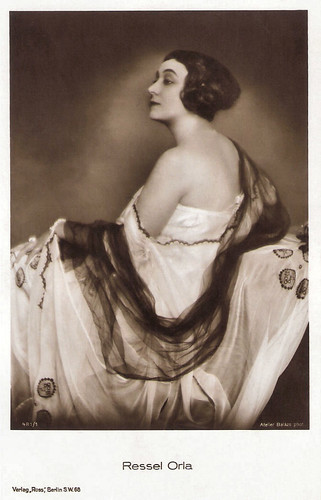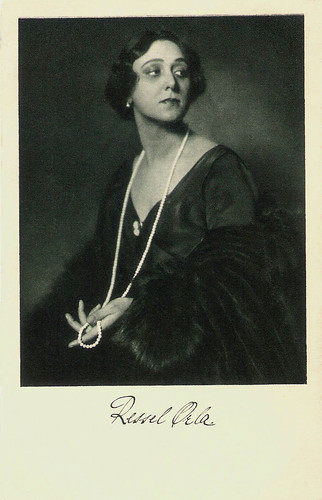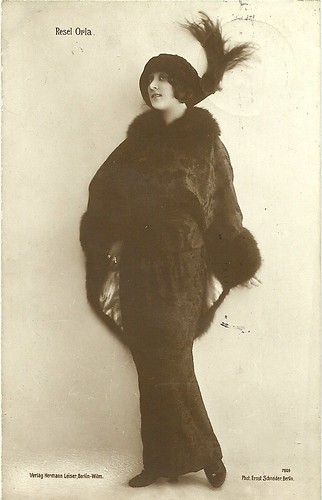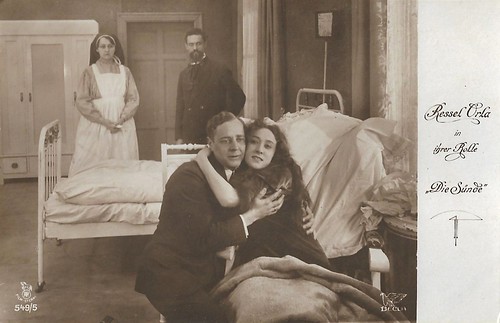Dark-haired and wide-eyed Ressel Orla (1889-1931) was a popular actress of the German silent cinema who peaked in the late 1910s and early 1920s. The now mostly forgotten star appeared in some of the early films by Ernst Lubitsch and Fritz Lang.

German postcard by Ross Verlag, Berlin, no. 395/2, 1919-1924. Photo: Atelier Balázs.

German postcard by Ross Verlag, Berlin, no. 481/1, 1919-1924. Photo: Atelier Balázs.

German postcard by Ross Verlag, Berlin, no. 481/2, 1919-1924. Photo: Atelier Balázs.

German postcard by Ross Verlag, Berlin, no. 481/3, 1919-1924. Photo: Atelier Balázs.
Ressel Orla was born Therese Ochs in Bozen (Bolzano) in Austria-Hungary (now Italy) in 1889.
In 1907 she began her stage career at the Metropoltheater in Hannover, Germany, and continued to play there in other theatres. In 1910 she moved to Düsseldorf, in 1912 to Bad Nenndorf, and finally to Berlin, where she played at the Residenztheater.
Here Walter Turszinsky discovered her and engaged her for the film comedy Die Firma heiratet/The Perfect Thirty-Six (Carl Wilhelm, 1914), for which Turszinsky had written the script. Her co-star was Ernst Lubitsch.
With no offers coming in for stage work, she continued film work with much success. Orla played in two other film comedies with Lubitsch either as actor or director, Die Stolz der Firma/The Pride of the Firm (Carl Wilhelm, 1914) and Blindekuh/Blind Cow (Ernst Lubitsch, 1915).
With her dark hair, her wide eyes, and her Madonna-like face, Orla conquered German audiences and became a star in the late 1910s. In 1918 she impersonated her first dramatic film role in Die Sünde/The Sin (Alwin Neuss, 1918). It was the first film of her own Ressel Orla film series for the Decla company of producer Erich Pommer.
Another of these films was Fritz Lang's first film direction Halbblut/The Half-Caste (1919). Earlier, Lang had been the scriptwritter for Orla's film Die Frauen des Josias Grafenreuth/The Women of Josef Grafenreuth (Otto Rippert, 1918). Her most important role was that of the dangerous and deadly Lio Sha, leader of a secret society of criminals in Lang's two-part adventure Die Spinnen/Spiders (Fritz Lang, 1919-1920) starring Carl de Vogt as a brave explorer.

German postcard by Verlag W.J. Morlins / Ross Verlag, Berlin, no. 9010/2. Photo: Karl Schenker.

German postcard by Verlag W.J. Morlins / Ross Verlag, Berlin, no. 9010/3. Photo: Karl Schenker.

German postcard by Rotophot in the Film-Sterne series. Photo: Karl Schenker, Berlin.

German postcard by Rotophot in the Film-Sterne series, no. 92/3, 1919-1924. Photo: Karl Schenker, Berlin.

German postcard by Verlag Hermann Leiser, Berlin-Wilm., no. 7809. Photo: Ernst Schneider, Berlin. Collection: Didier Hanson.
In the early 1920s, Ressel Orla made several films with director Carl Wilhelm, including Die Sippschaft/The Tribe (1920), Die Augen der Welt/The Eyes of the World (Carl Wilhelm, 1920) with Conrad Veidt, and Anständige Fraue/Decent Women (Carl Wilhelm, 1921).
After that, the expressive and beautiful Orla appeared in a whole series of films with director Leo Lasko such as Satansketten/Satan's chains (Leo Lasko, 1921), Pariserinnen/Parisians (Leo Lasko, 1921) with Xenia Desni, Lebenshunger/Lust for Life (Leo Lasko, 1921), and Die Lou vom Montmartre/Lou of Montmartre (Leo Lasko, 1921).
Other films in which she was the female protagonist were a.o. Monte Carlo (Fred Sauer, 1921), Die Wölfin/The She-Wolf (Rolf Brunner, 1921), Frau Schlange/Mrs. Snake (Eugen Holstein, 1923), and Frauen die den Weg verloren/Women Who Lost the Way (Bruno Rahn, 1926) with Oscar Marion.
Apart from these starring roles, Orla more and more had to share the female parts, with such actresses as Carola Toelle, Lya Mara, Henny Porten, Aud Egede Nissen, Claire Rommer, and Grit Haid. All through the 1920s, Ressel Orla performed in many films, though less frequent in the second half of the decade.
Her last film role was a small part in Lockendes Gift/Tempting Poison (Fred Sauer, 1929) with Paul Richter. In 1929 a terrible illness prevented her to continue performing and eventually, the illness killed her, in 1931 in Berlin. At the time of her death, she had fallen on hard times, was no longer acting, and was barely forty.

German postcard by Rotophot in the Film Sterne series, no. 502/1. Photo: Decla. Ressel Orla and Alwin Neuss in Die Faust des Schicksals/Fist of Doom (Alwin Neuss, 1917).

German postcard by Rotophot in the Film Sterne series, no. 502/3. Photo: Decla. Ressel Orla and Alwin Neuss in Die Faust des Schicksals/Fist of Doom (Alwin Neuss, 1917).

German postcard by in the Film Sterne series by Rotophot, no. 548/3. Photo: Decla. Ressel Orla in Das Glück der Frau Beate/The happiness of Mrs. Beate (Alwin Neuß, Otto Rippert, 1918). Plot: Though Beate's husband has become rich because of her, he repudiates her when suspecting her of adultery. Ressel Orla played the title role, Emil Birron her husband, and Max Ruhbeck the suitor. The film, scripted by Max Jungk and produced by Decla, had its first screening in 1918 at the Berlin cinema Marmorhaus.

German postcard by Rotophot in the Film Sterne series, no. 548/4, 1919-1924. Photo: Decla. Publicity still for Das Glück der Frau Beate/The luck of the Mrs. Beate (Alwin Neuss, Otto Rippert, 1918).

German postcard by Rotophot in the Film Sterne series, no. 549/1. Photo: Decla. Ressel Orla in Die Sünde/The Sin (Alwin Neuss, 1918).

German postcard by Rotophot in the Film Sterne series, no. 549/5. Photo: Decla. Ressel Orla in Die Sünde/The Sin (Alwin Neuss, 1918). The man she holds must be the actor Emil Birron.
Sources: Thomas Staedeli (Cyranos), Filmhistoriker.de, Filmportal.de, Wikipedia (German), and IMDb.
This post was last updated on 26 June 2021.

German postcard by Ross Verlag, Berlin, no. 395/2, 1919-1924. Photo: Atelier Balázs.

German postcard by Ross Verlag, Berlin, no. 481/1, 1919-1924. Photo: Atelier Balázs.

German postcard by Ross Verlag, Berlin, no. 481/2, 1919-1924. Photo: Atelier Balázs.

German postcard by Ross Verlag, Berlin, no. 481/3, 1919-1924. Photo: Atelier Balázs.
Madonna-like face
Ressel Orla was born Therese Ochs in Bozen (Bolzano) in Austria-Hungary (now Italy) in 1889.
In 1907 she began her stage career at the Metropoltheater in Hannover, Germany, and continued to play there in other theatres. In 1910 she moved to Düsseldorf, in 1912 to Bad Nenndorf, and finally to Berlin, where she played at the Residenztheater.
Here Walter Turszinsky discovered her and engaged her for the film comedy Die Firma heiratet/The Perfect Thirty-Six (Carl Wilhelm, 1914), for which Turszinsky had written the script. Her co-star was Ernst Lubitsch.
With no offers coming in for stage work, she continued film work with much success. Orla played in two other film comedies with Lubitsch either as actor or director, Die Stolz der Firma/The Pride of the Firm (Carl Wilhelm, 1914) and Blindekuh/Blind Cow (Ernst Lubitsch, 1915).
With her dark hair, her wide eyes, and her Madonna-like face, Orla conquered German audiences and became a star in the late 1910s. In 1918 she impersonated her first dramatic film role in Die Sünde/The Sin (Alwin Neuss, 1918). It was the first film of her own Ressel Orla film series for the Decla company of producer Erich Pommer.
Another of these films was Fritz Lang's first film direction Halbblut/The Half-Caste (1919). Earlier, Lang had been the scriptwritter for Orla's film Die Frauen des Josias Grafenreuth/The Women of Josef Grafenreuth (Otto Rippert, 1918). Her most important role was that of the dangerous and deadly Lio Sha, leader of a secret society of criminals in Lang's two-part adventure Die Spinnen/Spiders (Fritz Lang, 1919-1920) starring Carl de Vogt as a brave explorer.

German postcard by Verlag W.J. Morlins / Ross Verlag, Berlin, no. 9010/2. Photo: Karl Schenker.

German postcard by Verlag W.J. Morlins / Ross Verlag, Berlin, no. 9010/3. Photo: Karl Schenker.

German postcard by Rotophot in the Film-Sterne series. Photo: Karl Schenker, Berlin.

German postcard by Rotophot in the Film-Sterne series, no. 92/3, 1919-1924. Photo: Karl Schenker, Berlin.

German postcard by Verlag Hermann Leiser, Berlin-Wilm., no. 7809. Photo: Ernst Schneider, Berlin. Collection: Didier Hanson.
Terrible illness
In the early 1920s, Ressel Orla made several films with director Carl Wilhelm, including Die Sippschaft/The Tribe (1920), Die Augen der Welt/The Eyes of the World (Carl Wilhelm, 1920) with Conrad Veidt, and Anständige Fraue/Decent Women (Carl Wilhelm, 1921).
After that, the expressive and beautiful Orla appeared in a whole series of films with director Leo Lasko such as Satansketten/Satan's chains (Leo Lasko, 1921), Pariserinnen/Parisians (Leo Lasko, 1921) with Xenia Desni, Lebenshunger/Lust for Life (Leo Lasko, 1921), and Die Lou vom Montmartre/Lou of Montmartre (Leo Lasko, 1921).
Other films in which she was the female protagonist were a.o. Monte Carlo (Fred Sauer, 1921), Die Wölfin/The She-Wolf (Rolf Brunner, 1921), Frau Schlange/Mrs. Snake (Eugen Holstein, 1923), and Frauen die den Weg verloren/Women Who Lost the Way (Bruno Rahn, 1926) with Oscar Marion.
Apart from these starring roles, Orla more and more had to share the female parts, with such actresses as Carola Toelle, Lya Mara, Henny Porten, Aud Egede Nissen, Claire Rommer, and Grit Haid. All through the 1920s, Ressel Orla performed in many films, though less frequent in the second half of the decade.
Her last film role was a small part in Lockendes Gift/Tempting Poison (Fred Sauer, 1929) with Paul Richter. In 1929 a terrible illness prevented her to continue performing and eventually, the illness killed her, in 1931 in Berlin. At the time of her death, she had fallen on hard times, was no longer acting, and was barely forty.

German postcard by Rotophot in the Film Sterne series, no. 502/1. Photo: Decla. Ressel Orla and Alwin Neuss in Die Faust des Schicksals/Fist of Doom (Alwin Neuss, 1917).

German postcard by Rotophot in the Film Sterne series, no. 502/3. Photo: Decla. Ressel Orla and Alwin Neuss in Die Faust des Schicksals/Fist of Doom (Alwin Neuss, 1917).

German postcard by in the Film Sterne series by Rotophot, no. 548/3. Photo: Decla. Ressel Orla in Das Glück der Frau Beate/The happiness of Mrs. Beate (Alwin Neuß, Otto Rippert, 1918). Plot: Though Beate's husband has become rich because of her, he repudiates her when suspecting her of adultery. Ressel Orla played the title role, Emil Birron her husband, and Max Ruhbeck the suitor. The film, scripted by Max Jungk and produced by Decla, had its first screening in 1918 at the Berlin cinema Marmorhaus.

German postcard by Rotophot in the Film Sterne series, no. 548/4, 1919-1924. Photo: Decla. Publicity still for Das Glück der Frau Beate/The luck of the Mrs. Beate (Alwin Neuss, Otto Rippert, 1918).

German postcard by Rotophot in the Film Sterne series, no. 549/1. Photo: Decla. Ressel Orla in Die Sünde/The Sin (Alwin Neuss, 1918).

German postcard by Rotophot in the Film Sterne series, no. 549/5. Photo: Decla. Ressel Orla in Die Sünde/The Sin (Alwin Neuss, 1918). The man she holds must be the actor Emil Birron.
Sources: Thomas Staedeli (Cyranos), Filmhistoriker.de, Filmportal.de, Wikipedia (German), and IMDb.
This post was last updated on 26 June 2021.
No comments:
Post a Comment